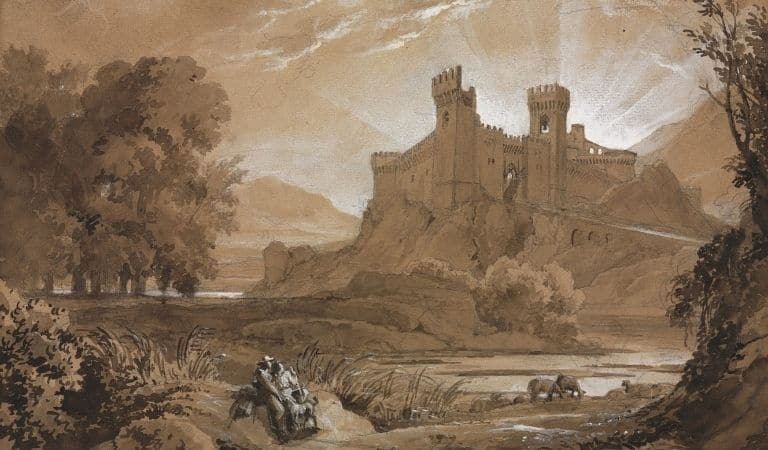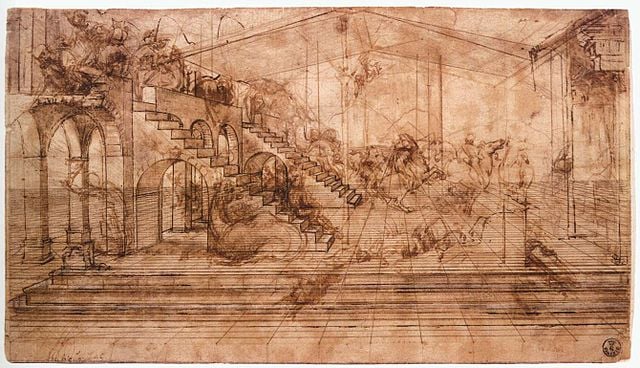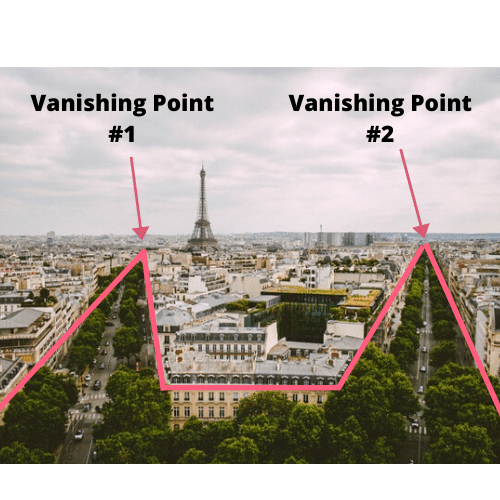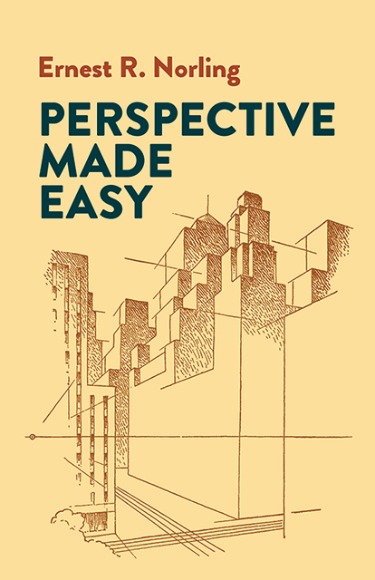Perspective drawing is one of those fundamental techniques that will not just improve your drawing and painting but it will also help you to create more convincing images. Getting a grasp on perspective for drawing, will also increase your confidence as an artist. As its understanding, allows you to be certain about what direction an angle should or shouldn’t be at in your art.
In this article, I will be going over the basics of drawing in perspective. I have included a great resource at the bottom of this article that I highly recommend!
What is perspective drawing in art?

Perspective drawing gives a three dimensional feel to an otherwise 2D surface. It is what helps to create a believable sense of space in drawings, as well as paintings. With it, you will be able to portray an object with a sense of dimension, so that it doesn’t lay flat like the surface it’s drawn or painted upon.
There are two main different types of perspective drawing in art: linear perspective and atmospheric perspective.
All about linear perspective drawing
The basics of linear perspective
With linear perspective drawing there is one point, two point, and even three point perspective. By using the elements of linear perspective we are able to arrange objects on a canvas or piece of paper similar to how we would see it in the real world. Objects that are closer to us appear larger while objects that are further away appear smaller.

How linear perspective works
We will take a look at this drawing in one point perspective example below, to show how linear perspective drawing works. First, a horizontal line is placed across the surface of a picture – as you can see in the image diagram below. This line is known as the horizon line. Parallel lines then meet and converge as they recede back into space at what is called the vanishing point in art.

Vanishing point in art
You can see where the vanishing point is in the drawing above. This is the point where the train tracks meet far off in the distance. The rails go on and on across the level plain until they reach the horizon where they are lost from sight.

Here is a real life example of one point perspective in a scene you might encounter on a road trip. Notice the parallel lines and the vanishing point far off in the distance where both points converge at the one point.
One point perspective drawing in action

One point perspective is when a drawing has a single origin and vanishing point on the horizontal line. Leonardo da Vinci’s “Adoration of the Magi” is an excellent example of one point perspective drawing. Notice how all of the lines, from the steps to the arches all converge at the same spot on the horizon line.
Da Vinci’s drawings are full of great lessons to learn from and his drawing above is a great example of one point perspective in a more complex scene. He did not leave any stone unturned in his efforts to get a precise and accurate understanding of drawing in perspective.
What is two point perspective?
Two point perspective can also be called angular perspective or three quarter perspective. In simple terms two point perspective is when there are two separate vanishing points.

Notice this concept of two point perspective at play in this real life photo of a view of Paris. There isn’t just one but rather two vanishing points. One side of the building in the center will vanish off to the right and the other to the left.
Two point perspective drawing in art

Here is another Parisian inspired example of two point perspective. In the upper left we see the building and how one side of the building vanishes off to the right. While the other side vanishes off to the left – thus creating two separate vanishing points.
Atmospheric perspective
What is atmospheric perspective? Like linear perspective, atmospheric perspective also gives an illusion of depth and space on a two dimensional surface. However, in place of lines and vanishing points, color is primarily used.
Leonardo da Vinci is credited with first coining the term atmospheric perspective. In his ‘treatise on painting’ he observed. That colors “become weaker in proportion to their distance from the person who is looking at them”.
So for example, things far off in the distance are typically lighter in color. While things close up are stronger and darker in color. This principle can therefore be used in painting, by painting elements far off in the distance lighter in color and things that are close up much darker.
Example of atmospheric perspective in art

By Joseph Mallord William Turner, Regulus
Here is a clear example of atmospheric perspective in art in this painting by JMW Turner. We can see how the areas that are further away are lighter. While the areas that are closer to the front are darker in color.
Where to learn more about drawing in perspective?
I highly encourage you to deepen and broaden your understanding of perspective in art. Drawing in perspective will not only help you to feel more confident when drawing and painting. But it will also help you to create a very believable sense of space in your work. Art becomes a much more powerful visual experience, when you can feel that it has a clear sense of space.
Perspective drawing how to resource
Perspective Made Easy by Ernest R. Norling
Perspective Made Easy, is a great perspective drawing how to resource that I recommend for you to check out. This book simplifies and breaks down every aspect of drawing in perspective, in a very easy to understand way. It sheds light on perspective for drawing in a way you may not have understood before.






10 thoughts on “Perspective Drawing How to Guide For Beginners”
Your art lessons and the illustrations provided are
so very helpful to art beginners like myself. I have learnt more from you than I did at a year and a half in art school.. thank you for your efforts to teach and enlighten us on the fundamentals, its so appreciated.
Di Byrnes Australia.
Hi Diane, Am very glad that my art lessons have been helpful for you! It is my pleasure to be able to share 🙂
Im hungryfor this knowledge about drawing and perspective. Thanks
Hi Kathy, So glad that information was helpful to you. If you want to learn more about perspective I definitely recommend the book that I list at the bottom of the article. Have fun drawing! 🙂
Thank you for giving us a tutorial that’s thorough, and well done.
HI Rhonnie, You are so welcome!
תודה רבה על ההסבר
להבנת פרספקטיבה תודה על המידע המקצועי
ההבהרות ודרך הצגתם והמחשתם
בבקשה שלחי לי בקשה את הפרק של ערבוב צבעים
תודה רבה
ערב נעים
רותי כהן
jonatanr@zahav.net.il
תודה רבה לך! אני מעריך את זה. פשוט שלחתי לך את מדריך ערבוב הצבעים לדואר האלקטרוני שלך
Dear Elizabeth,
Thanks for all the material provided. This perspective simple guide provides a sound working understanding to build on. The same goes for all the other feedback you give to anyone interested. Well explained with ample examples. A very good teacher to rely on.
Hello Stelios – thank you! I am glad that this guide is helpful for you as well as the other information found here.